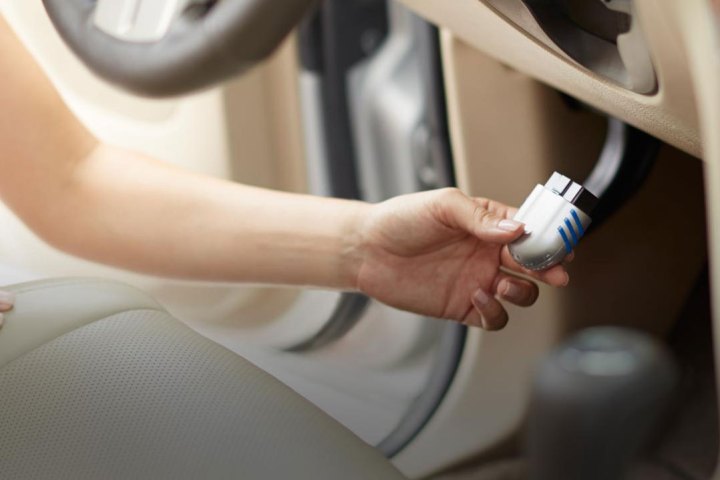
We’ve written before about the transmitters that insurance companies try to get you to install in your car to report on your driving habits. Those devices are not designed for your benefit, and should still be avoided in our opinion, but there’s far more information inside your car that you can use with the right device.
With the right device, you can access detailed information about your trips, your car’s performance, and even automate some of your interactions with government agencies through Vehicle-to-Infrastructure (V2I) and Vehicle-to-Government (V2G) communications.
A new class of device
Recently, a San Francisco company called Automatic released a device that can allow you to get at more of the data your car is generating, and it could even save you time and hassle at registration renewal time.
The device is called the Automatic Lite, and it plugs into your car’s On Board Diagnostic (OBD-II) port, and then connects via Bluetooth to your phone. Automatic also includes apps for both iOS and Android to let you access the information provided. Verizon Wireless offers a similar device called Hum by Verizon.
With the right device, you can access detailed trip info, your car’s performance, and even automate some of your interactions with government.
There’s a great potential for these and similar products to enhance your ability to manage your car more efficiently. For example, if your car displays the check engine light, it could mean any number of problems, from a loose spark plug wire to an imminent major breakdown. Typically, you have to go to the dealer or an independent mechanic to have the error code translated for you, or you have to own your own code reader and look up the code yourself. With this kind of on-board technology, you can display the code on your phone. The device’s app will even interpret the code for you and tell you what it means.
With a device monitoring your car for you, you can keep track of every driving trip you make, and export the mileage data to a spreadsheet or expense report format. The associated apps let you apply tags to trips and export the data in several commonly used formats. There’s even a selection of additional apps that work with the device to display operating data from your car as you drive.
The Verizon Hum device also integrates with a navigation app on your phone to give you turn-by-turn directions through a clip-on speaker, and access to business discounts based on your location. And if you have a teen driver, the Hum device allows you to generate a report card on their driving.
This may sound like a commercial for Automatic or Hum, but it’s not – it’s just pointing the way to the next generation of connected car apps and looking at how they’re going to work for you. Other companies such as Azuga are marketing similar devices, although Azuga is oriented towards fleet services. Automakers are also likely to build the same kind of technology directly into cars very shortly.
The end of the smog test
One benefit of the new technology could be an end to the traditional smog test. If your car was made after 1996, it’s got OBD-II and the car knows if its emissions systems are functioning correctly. The car is smog-testing itself all the time.

Instead of wasting an hour or more taking your car for a smog check, there’s no reason you shouldn’t be able to authorize a transmission of your car’s emissions status to the appropriate governing body and pay your registration fees online. Presto, your tags are renewed just like that. Some 30 states have already started working with companies like Automatic to implement this kind of emissions testing.
With smog tests and registration renewals showing the way, other government interactions that could be automated might include toll and parking payments, mileage taxes (if implemented) for electric and hybrid vehicles, and even special congestion taxes as have been implemented in extraordinarily crowded cities like London, England. Conceivably, the concept can even be extended to Vehicle-to-Infrastructure communications that will smooth traffic flow through complex intersections.
Maintaining your privacy
If you’re a little bit (or a lot) wary of broadcasting that much information about your car and your driving habits, you’re not wrong. It’s easy to imagine the VtoG data stream being used to fine you for every time you exceed the speed limit, or for your insurance company to raise your rates every time you accelerate faster than they think is prudent.
If you have a teen driver, the devices will allow you to generate a detailed report card on their driving for them.
It’s one thing to prepare a report on your own driving or your child’s driving for your own reference, and quite another for an outside entity to be keeping tabs on your car. If you accept any such device, it will be to your advantage to understand who has access to this data and what they may do with it.
As cars become more autonomous over the next decade, the flow of data available from every car will expand even further, to include real-time camera and radar imaging of every street in every city. Government entities are looking to capitalize on this data flow to implement real-time automated traffic management, and certainly law enforcement will be interested in the view from every automobile on the road.
The bottom line is simple – with attachments today and built-in features tomorrow, automation in your car has the potential to make your life more convenient, but also less private. It will be up to each of us to decide how far we want to go with such technology, and to keep an eye out for potential abuse.


